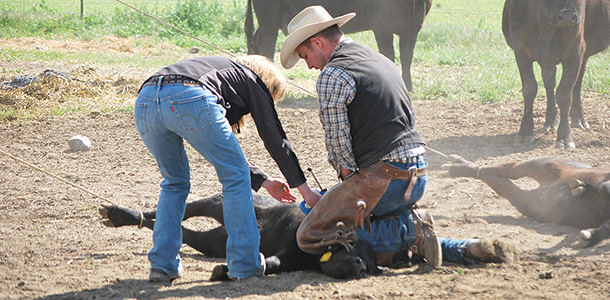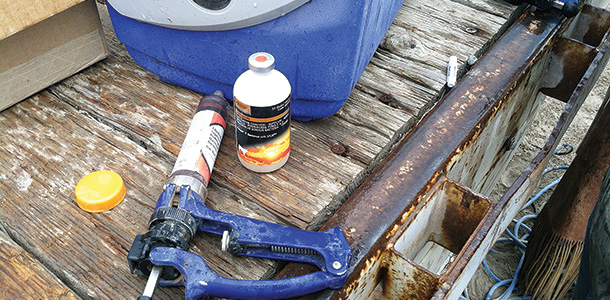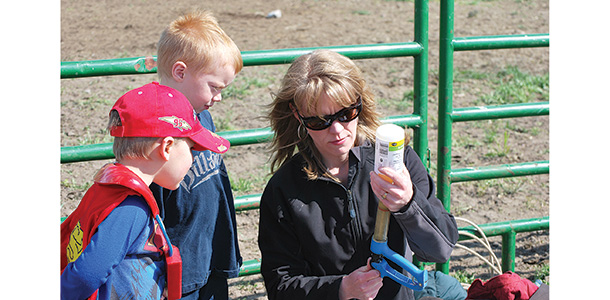If you have ever experienced bad digestion, traveler’s revenge or perhaps just good old-fashioned burn-your-backside diarrhea the day after a picnic and wondered why, listen up and pay attention. There is a chance you are a one-cooler kind of person.
While monogamy is considered to be a good thing in some areas of life, it may not be when it comes to coolers.
Ask any food safety expert, and they will tell you if you go on a picnic, take two coolers: one for food and one for drinks. The drink cooler gets opened constantly, thus making it harder to keep cool.
Now, let’s say you only took one cooler to that picnic. It was a hot day, the cooler lid was opened constantly to keep the cold drinks flowing, the cooler kept getting warmer – and that potato salad kept getting warmer too.
That digestive upset you’re feeling is starting to make a little more sense, huh?
That same principle applies to keeping vaccine cool while you are chuteside or in the branding pen.
If you only have one cooler to open every time you need to fill your shotgun (an adjustable dosage-repeater syringe, for those who demand proper diction), just remember our potato salad lesson. It’s time to re-think our cooler monogamy.
Recently, there has been a lot of good information being put out to producers on vaccine handling and storage.
There is one heck of an article that everyone should read. You can check it out (Cattle Vaccine Handling and Management Guidelines).

Keeping vaccine cool enough
The cattle industry loses $900 million a year to disease, and vaccines account for approximately $15 per head per year for a typical cow-calf producer, so let’s not waste our money.
We know to keep our vaccine in a cooler while out in the field, and that we want it stored between 35 to 45°F. But does keeping the vaccine in the cooler matter if we constantly open the thing every time a calf gets dragged to the fire?
This past spring, I was determined to answer that very question. I took advantage of three brandings to begin comparing different methods of storing vaccine in a working setting.
At the first branding, I learned that an ambient air temperature of 80°F on a sunny day will result in the surface of a flatbed pickup being 100°F (yeah, I know … I’ve never put vaccine on the back of my flatbed either – except for maybe that one time, and that other time, and then there may have been that other time…).
The producer at Branding No. 1 has a practice of always using two coolers. He had one hard-sided cooler to store unmixed vaccine and one to store shotguns and mixed vaccine.
One cooler was only opened to pull out fresh bottles of vaccine, and it was stored in the shade under the truck. Once vaccine bottles were mixed, they were placed in a separate lunchbox-sized cooler, along with the shotguns.
This smaller cooler was kept on the back of the truck because – let’s face it – in a branding pen, it’s a handy place to keep it. Each cooler had cold packs to keep vaccine cool.
This method kept the stored vaccine at a temperature of 35 to 40°F throughout the entire eight hours that we gathered, branded, broke for lunch and branded another group of calves.
When we started branding at 9 a.m., the cooler that held the syringes and the mixed vaccine was 40°F; by the end of the day it was 65°F.
At first, this may seem like it was too warm in the syringe cooler, but we have to remember that each 50-dose vial was only in the syringe cooler for approximately an hour, which means the first doses used were closer to storage temperature, and the last doses used were most likely no warmer than 65°F.

According to what we know about a vaccine’s chemical structure, at the time of injection the vaccine should have still been viable because it wasn’t above any critical temperature long enough to lose efficacy.
This could have been improved even more if we had added fresh cold packs midway through the branding.
This scenario was repeated at Branding No. 2 on an overcast 75°F day. At the end of the day, the inside of the syringe cooler was 54°F.
Again, we should have kept the integrity of the vaccine intact on this day as well. In these two cases, we weren’t just punching holes in the hide – the vaccine was adequately stored and we went home feeling good that we had given effective and viable vaccine.
The third branding was on a sunny 80°F day. At Branding No. 3, all vaccines and syringes were stored in the same dark-colored, soft-sided cooler – and of course, cold packs were placed in the cooler to try to keep things cool.
The cooler was kept on the back of a truck during gathering and then placed on the ground at the edge of the branding pen in the sun.
At the start of the branding, the temperature in the cooler had already reached 65°F, and because the cooler was opened and closed so often, the cooler had reached 75°F within one hour and was at 80°F by the end of two hours, where it stayed for another two hours.
Were we just punching holes in the hide and giving the calves an unviable vaccine? Maybe not at the beginning, but by the end it may be a different story.
We do know this vaccine was warmer than it should have been for far too long. This is not to criticize the producer at the third branding – in fact, I would have to say that, looking back on my life, Branding No. 3 may be more the norm than the exception when it comes to the spring and fall workings of cattle.
Even though I only took observations at three brandings, the data I collected is enough to make us think about how many and what types of coolers we need to be packing to the chute or the branding pen.
Shannon Williams, University of Idaho extension educator in Lemhi County, compared the storage temperatures between hard-sided, soft-sided and Styrofoam coolers and found that hard-sided coolers were most effective at maintaining proper temperatures.
Coolers will also maintain proper temperature best when packed with cold packs on the sides as well, rather than just putting cold packs on the bottom.

Keeping vaccine warm enough
We’ve been focusing on keeping vaccine cool enough, but when we’re working cattle in the late fall and winter, we need to be conscious of vaccine getting too cold as well.
A frozen vaccine is not good. The entire chemical structure of most vaccines will be altered by freezing, and vaccine should never be used once it has frozen.
Some guidelines to follow to keep vaccine warm enough in cold weather are as follows:
- At temperatures between 35 and 45°F, place the vaccine in the cooler with no cold packs or heat packs and store the cooler in the shade.
- Two cups of boiling water in a glass jar placed in a hard-sided cooler should keep the vaccine above 35°F for 4½ hours when it is 29°F outside, but will only keep it above 35°F for three hours if it is 13°F outside.
Take-home points
- Follow all suggestions in the article “Cattle Vaccine Handling and Management Guidelines.” The link to this article can be found on the Progressive Cattleman website with this story.
- Take two hard-sided coolers to the processing area: one for unmixed and stored vaccine, and one for mixed vaccine and syringes.
—Excerpts from University of Idaho Twin Falls County Magic Valley Beef newsletter, Vol. 1 Issue 1, August 2013
PHOTOS
PHOTO 1: Fill syringes as quickly as possible and get the vaccine back in the cooler and out of the sunlight.
PHOTO 2: As soon as shots are administered, make every effort to get the syringe back in the cooler ASAP.
PHOTO 3: While we have all left our syringes and vaccine exposed before, try to avoid this scenario.
PHOTO 4: Take time to teach our next generation about vaccine handling. Photos courtesy of Billy Whitehurst.
Billy Whitehurst
University of Idaho Extension – Twin Falls County








